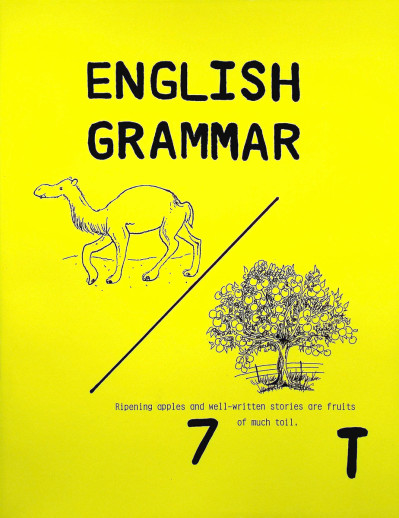We use cookies to make your experience better. To comply with the new e-Privacy directive, we need to ask for your consent to set the cookies. Learn more.
English Grammar 7 Teacher
Pages are duplications of the student book with answers mostly written in cursive. No answers are provided for any of the writing assignments. 163 pgs, pb. ~ Ruth
These materials offer a complete and comprehensive coverage of all three elements - grammar (i.e. parts of speech, complete sentences), usage (i.e. homophones, figures of speech, proper word choice to convey meaning), and mechanics (i.e. punctuation, capitalization).
Affordability, product simplicity, solid academics: these are values we associate with a conservative Amish program. In this grammar series by author Pollyanna Yoder, you'll also spy some periodic visual clues: black-and-white typed texts (a large, sans-serif font in Grades 1-3); hand-written answers (includes cursive at Grade 4); the minimal, hand-sketched, Amish-friendly drawings (bearded stick figures, a yoke, farm animals, etc.); some practical vocabulary not usually emphasized in elementary years (curd; spathe; spark plug); and brief instances of country slang (such as Ain't/Hain't) that are identified as improper in written English. These Amish references are rare and are endearing rather than confusing.
This program could dovetail nicely with the Pathway Readers (to which it is loosely aligned) or alongside any language arts program that lacks a focused grammar instruction. Many exercises involve correcting with editing skills (proofreaders marks, deletions, marking, labeling, diacritical marks, etc.) and correcting rather than completely rewriting the sentence.
Students ease in at Grade 1, beginning with overviewing phonics and then transitioning to simple grammar labeling at the year's end. At Grade 2, however, students jump in with both feet, learning nouns; verbs; prepositional phrases; using proofreading skills; and more. After Grade 2, each book is divided into six consumable units. While the table of contents identifies concepts covered, the scope isn't obvious. As students work through each grade level, there's a good balance of new concepts and review, with approximately 120 lessons per level.
Basic grammar terms are taught (such as nouns, synonyms, prefixes, sentence types, etc.) and then immediately practiced. Keep an eye out for the special animal assigned to each grade (i.e., Patty Parrot in Grade 3 and Flora Flamingo in Grade 4). You'll find them sprinkled throughout each level, alerting your student to new concepts. A grammar concept is often introduced by first describing it rather than naming it (such as explaining a diphthong as "two vowels beside each other"). Lessons are always bite-sized; tasks balance between students identifying provided samples and then replicating the concept correctly in their own writing (space provided). There is a "build-upon-each-concept" review, but new concepts will be sprinkled in throughout in a makes-sense way rather than a chapter-by-chapter approach. Most levels primarily employ the labelling approach to grammar identification. By the end of Grade 6, students will have a firm grasp of all concepts previously studied: pronunciation (via learning diacritical marks such as those found in a dictionary), essential grammar, and punctuation. Level 6 introduces diagramming, but most assignments still employ the labeling technique and drawing arrows to point out modifiers. See each specific grade's individual descriptions for content details. Level 7 will periodically interject Scripture in the grammar lessons.
Students
will apply grammar skills using the included (albeit short and few) writing
assignments. The assignments are not designed to meet full composition course
goals, but instead to periodically and creatively apply the grammar concepts
learned. No suggested responses for these are included in the Teacher material.
These short writing assignments allow some student creativity and grammar
practice. Assignments are sprinkled throughout the levels, beginning in level 2
with just a sentence or two. In Level 3, for example, the student is asked:
"Have you ever broken something? What did you do? Write a 20-word
paragraph." In Level 6, "research and write a report about the moose
and answer whether a moose can protect himself from wolves without running
away." In Level 7, assignments include writing a poem, writing 4
paragraphs about an animal, creating a life story of a dime, or imagining your
life if you were strong as Samson, etc. Throughout the course, students are
often directed to use tangible resources like dictionaries and encyclopedias.
Teacher books (currently available for Grades 2-7) provide answers for lessons and tests (6 tests per level, in Grades 3-7 only) included in the Student Consumable books. One student consumable copy of the course's tests is provided with the student book (Grades 3-7) and are not sold separately. While Grade 1 does not currently have a Teacher book, answers are self-explanatory. In the Levels 4-7 Teacher books, answers are often written in cursive. This solid, practical, and easy-to-use program helps students apply pronunciation, grammar, and mechanics in their writing. ~ Ruth
| Product Format: | Paperback |
|---|---|
| Brand: | Pollyanna Yoder |
| Grade: | 7 |
| Length in Inches: | 11 |
| Width in Inches: | 8.5 |
| Height in Inches: | 0.375 |
| Weight in Pounds: | 0.95 |

